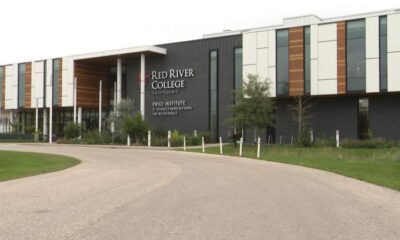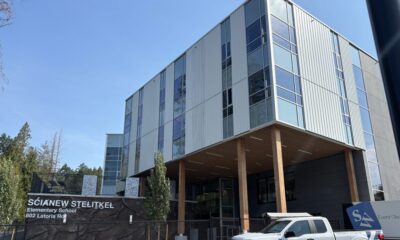Science
New Therapy Uses Nanofibers to Enhance Cartilage Regeneration

A novel therapy employing synthetic nanofibers has shown promising results in enhancing cartilage repair. Researchers found that increasing the motion of molecules within these nanofibers stimulates the production of essential components for cartilage regeneration. This innovative approach could transform the treatment landscape for osteoarthritis, a degenerative disease that impacts nearly 530 million people globally.
Osteoarthritis gradually deteriorates joint tissues, leading to pain and disability. A team from Northwestern University, led by Samuel I. Stupp, previously developed a similar injectable therapy to repair tissues following severe spinal cord injuries. They have now adapted this strategy for damaged human cartilage cells.
The recent study demonstrated that the therapy activated gene expression required for cartilage formation within just four hours. Remarkably, by day three, the treated human cells began producing the proteins crucial for cartilage regeneration. The effectiveness of the treatment was directly correlated with the speed of molecular motion; the more dynamic the molecules, the greater the treatment’s impact.
Mechanism Behind the Therapy
The nanofibers mimic the extracellular matrix of surrounding tissues. By replicating the matrix’s structure and incorporating bioactive signals, these synthetic materials facilitate communication with cells. The focus of the research was on receptors for a specific protein vital to cartilage formation and maintenance.
To effectively target this receptor, the team engineered a new circular peptide mimicking the bioactive signal of the protein known as transforming growth factor beta-1 (TGFb-1). They then integrated this peptide into two distinct supramolecular polymers that interact to form larger structures in water, each capable of emulating TGFb-1’s signaling.
One polymer was designed to allow molecules to move freely, while the other restricted motion. Although both were capable of activating the TGFb-1 receptor, the polymer with more mobile molecules demonstrated significantly higher effectiveness. In fact, it surpassed the natural protein in activating this receptor, marking a significant advancement in regenerative medicine.
Future Implications and Research
The findings of this study appear in the Journal of the American Chemical Society, in an article titled “Supramolecular motion enables chondrogenic bioactivity of a cyclic peptide mimetic of transforming growth factor-β1.” The research opens new avenues for developing treatments aimed at alleviating the burden of osteoarthritis and enhancing the quality of life for millions affected by this debilitating condition.
This innovative approach not only highlights the potential for synthetic therapies in tissue regeneration but also emphasizes the importance of molecular dynamics in biological processes. As further research unfolds, the hope is that such therapies can lead to effective solutions for cartilage repair and potentially other degenerative diseases.
-

 Education3 months ago
Education3 months agoBrandon University’s Failed $5 Million Project Sparks Oversight Review
-

 Science4 months ago
Science4 months agoMicrosoft Confirms U.S. Law Overrules Canadian Data Sovereignty
-

 Lifestyle3 months ago
Lifestyle3 months agoWinnipeg Celebrates Culinary Creativity During Le Burger Week 2025
-

 Health4 months ago
Health4 months agoMontreal’s Groupe Marcelle Leads Canadian Cosmetic Industry Growth
-

 Science4 months ago
Science4 months agoTech Innovator Amandipp Singh Transforms Hiring for Disabled
-

 Technology4 months ago
Technology4 months agoDragon Ball: Sparking! Zero Launching on Switch and Switch 2 This November
-

 Education4 months ago
Education4 months agoRed River College Launches New Programs to Address Industry Needs
-

 Technology4 months ago
Technology4 months agoGoogle Pixel 10 Pro Fold Specs Unveiled Ahead of Launch
-

 Business3 months ago
Business3 months agoRocket Lab Reports Strong Q2 2025 Revenue Growth and Future Plans
-

 Technology2 months ago
Technology2 months agoDiscord Faces Serious Security Breach Affecting Millions
-

 Education4 months ago
Education4 months agoAlberta Teachers’ Strike: Potential Impacts on Students and Families
-

 Education3 months ago
Education3 months agoNew SĆIȺNEW̱ SṮEȽIṮḴEȽ Elementary Opens in Langford for 2025/2026 Year
-

 Science4 months ago
Science4 months agoChina’s Wukong Spacesuit Sets New Standard for AI in Space
-

 Business4 months ago
Business4 months agoBNA Brewing to Open New Bowling Alley in Downtown Penticton
-

 Business4 months ago
Business4 months agoNew Estimates Reveal ChatGPT-5 Energy Use Could Soar
-

 Technology4 months ago
Technology4 months agoWorld of Warcraft Players Buzz Over 19-Quest Bee Challenge
-

 Business4 months ago
Business4 months agoDawson City Residents Rally Around Buy Canadian Movement
-

 Technology4 months ago
Technology4 months agoFuture Entertainment Launches DDoD with Gameplay Trailer Showcase
-

 Technology2 months ago
Technology2 months agoHuawei MatePad 12X Redefines Tablet Experience for Professionals
-

 Top Stories3 months ago
Top Stories3 months agoBlue Jays Shift José Berríos to Bullpen Ahead of Playoffs
-

 Technology4 months ago
Technology4 months agoGlobal Launch of Ragnarok M: Classic Set for September 3, 2025
-

 Technology4 months ago
Technology4 months agoInnovative 140W GaN Travel Adapter Combines Power and Convenience
-

 Science4 months ago
Science4 months agoXi Labs Innovates with New AI Operating System Set for 2025 Launch
-

 Technology4 months ago
Technology4 months agoNew IDR01 Smart Ring Offers Advanced Sports Tracking for $169










